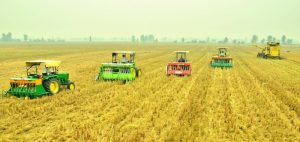
EL BATAN, Mexico (CIMMYT) — In conjunction with recent state regulations outlawing the use of fire to destroy field crop waste in northwest India, some farmers are benefitting from technological innovations that can help prevent damaging smog levels in the capital Delhi and other areas, according to scientists.
Currently, the majority of farmers in northwest India burn leftover vegetation residue to prepare fields for planting in cyclical rice-wheat crop rotations, leading to negative consequences for soil quality, the environment, animal and human health. Rice-wheat crop rotations make up 84 percent of burned crops, a key source of atmospheric pollution.
“Farmers need access to appropriate machinery and training to implement change to discourage burning,” said M.L. Jat, a systems agronomist who works in New Delhi with the International Maize and Wheat Improvement Center (CIMMYT). “Using crop residue in a sustainable and eco-friendly manner could benefit all stakeholders.”
Many farmers keep costs low by burning residue on the farm, rather than paying for its removal for other uses, which could include animal feed, biofuel, incorporating it into the soil or retaining it in the field as mulch, according to a research paper titled “Burning issues of paddy residue management in northwest fields of India.” Fire is also used to eliminate weeds, pests, disease and remaining field stubble after harvest.
Ash left on the fields after residue burning increases the availability of some nutrients, while depleting others and negatively affecting soil health in the long term. During burning, soil temperature increases, bacteria and fungi are killed off, regenerating in a matter of days. Residue burning can damage plants and trees on field edges with negative implications for the overall ecosystem.
Residues can be used as a renewable energy source to improve air, soil quality, climate change and reduce global warming, provided these are economically viable options for farmers. Incentives could also help encourage farmers to leave residues on their fields for use as fertilizer.
If residue is mulched into the soil, nutrient levels improve and carbon sequestration capacity increases, lowering the release of greenhouse gases into the environment. Additionally, residue retention reduces evaporation and increases soil moisture by as much as 10 percent during the wheat-growing season.
Farmers can benefit from the Happy Seeder, a machine that can plant wheat seed directly into the soil by boring through crop residue. The Straw Management System (SMS) machine spreads straw residue thinly on the soil surface allowing seeding.
“Residues are also of great economic value as livestock feed, fuel and industrial raw materials, but of the total rice residues produced in northwestern India, only around 15 percent can potentially be used for these purposes and the rest must be managed with in-situ (on site) management technologies,” said Jat, who conducted the research in collaboration with the CGIAR research programs on maize (CRP Maize), wheat (CRP Wheat) and climate change, agriculture and food security (CCAFS).
“Although farmers are aware of the adverse affects of crop burning, they rely on it due to the lack of economically viable and acceptable machinery and alternatives to dispose of residue.”
However, deploying advanced technology, including the concurrent use of straw management systems, fitted combine harvesters and Happy Seeders for direct drilling is a viable solution to eliminate burning, he added.
With these advancements and aggressive campaigns, within a period of a couple of months in Punjab state alone, over 1,000 combine owners have launched a “Super SMS.”
Additionally, nearly 2,000 happy seeders are being manufactured, which will lead to large-scale adoption of conservation agriculture techniques in the upcoming wheat season, Jat said.
Related articles:
The Evergreen Revolution: Six ways to empower India’s no-burn agricultural future
New study uncovers climate footprint of India’s favorite foods
Advice for India’s rice-wheat farmers: Put aside the plow and save straw to fight pollution
New Dehli air pollution causes United Airlines flight cancellations
 Climate adaptation and mitigation
Climate adaptation and mitigation